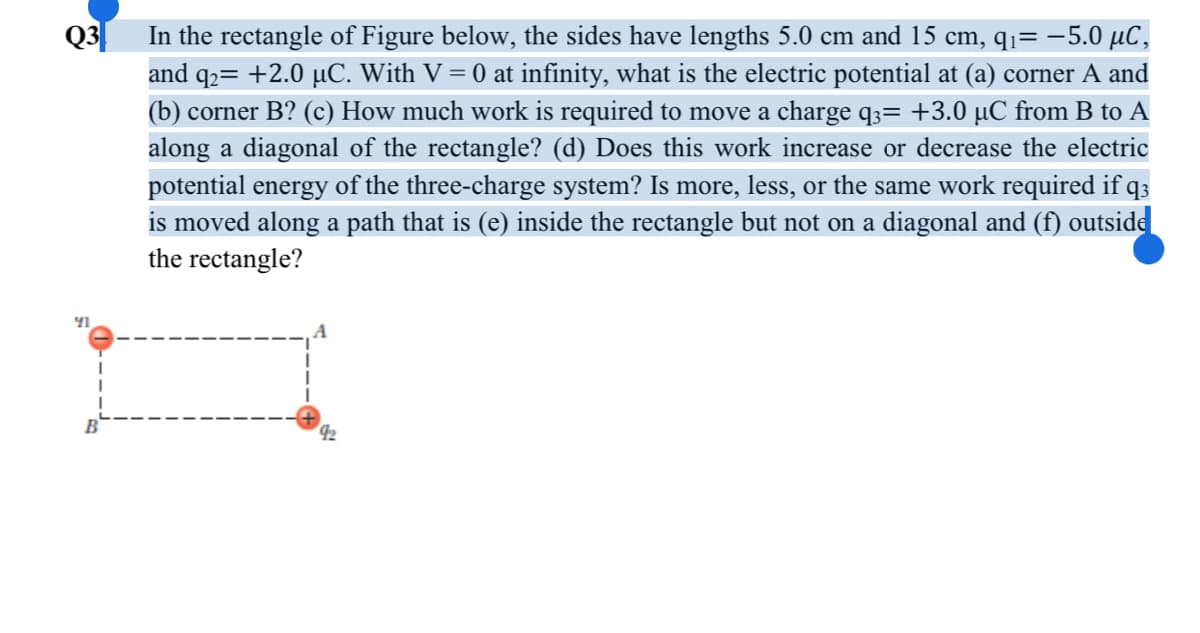Q3| In the rectangle of Figure below, the sides have lengths 5.0 cm and 15 cm, qı= -5.0 µC, and q2= +2.0 µC. With V = 0 at infinity, what is the electric potential at (a) corner A and (b) corner B? (c) How much work is required to move a charge q;= +3.0 µC from B to A along a diagonal of the rectangle? (d) Does this work increase or decrease the electric potential energy of the three-charge system? Is more, less, or the same work required if q3 is moved along a path that is (e) inside the rectangle but not on a diagonal and (f) outsidd the rectangle? 42
Q3| In the rectangle of Figure below, the sides have lengths 5.0 cm and 15 cm, qı= -5.0 µC, and q2= +2.0 µC. With V = 0 at infinity, what is the electric potential at (a) corner A and (b) corner B? (c) How much work is required to move a charge q;= +3.0 µC from B to A along a diagonal of the rectangle? (d) Does this work increase or decrease the electric potential energy of the three-charge system? Is more, less, or the same work required if q3 is moved along a path that is (e) inside the rectangle but not on a diagonal and (f) outsidd the rectangle? 42
Physics for Scientists and Engineers: Foundations and Connections
1st Edition
ISBN:9781133939146
Author:Katz, Debora M.
Publisher:Katz, Debora M.
Chapter26: Electric Potential
Section: Chapter Questions
Problem 38PQ
Related questions
Question
100%
. In the rectangle of Figure below, the sides have lengths 5.0 cm and 15 cm, q1 , and q2 μC. With V = 0 at infinity, what is the electric potential at (a) corner A and (b) corner B? (c) How much work is required to move a charge q3 μC from B to A along a diagonal of the rectangle? (d) Does this work increase or decrease the electric potential energy of the three-charge system? Is more, less, or the same work required if q3 is moved along a path that is (e) inside the rectangle but not on a diagonal and (f) outside the rectangle?

Transcribed Image Text:Q3|
In the rectangle of Figure below, the sides have lengths 5.0 cm and 15 cm, qq= -5.0 µC,
and q2= +2.0 µC. With V = 0 at infinity, what is the electric potential at (a) corner A and
(b) corner B? (c) How much work is required to move a charge q;= +3.0 µC from B to A
along a diagonal of the rectangle? (d) Does this work increase or decrease the electric
potential energy of the three-charge system? Is more, less, or the same work required if q3
is moved along a path that is (e) inside the rectangle but not on a diagonal and (ff) outside
the rectangle?
42
Expert Solution
This question has been solved!
Explore an expertly crafted, step-by-step solution for a thorough understanding of key concepts.
This is a popular solution!
Trending now
This is a popular solution!
Step by step
Solved in 3 steps

Knowledge Booster
Learn more about
Need a deep-dive on the concept behind this application? Look no further. Learn more about this topic, physics and related others by exploring similar questions and additional content below.Recommended textbooks for you

Physics for Scientists and Engineers: Foundations…
Physics
ISBN:
9781133939146
Author:
Katz, Debora M.
Publisher:
Cengage Learning

Physics for Scientists and Engineers
Physics
ISBN:
9781337553278
Author:
Raymond A. Serway, John W. Jewett
Publisher:
Cengage Learning

Physics for Scientists and Engineers with Modern …
Physics
ISBN:
9781337553292
Author:
Raymond A. Serway, John W. Jewett
Publisher:
Cengage Learning

Physics for Scientists and Engineers: Foundations…
Physics
ISBN:
9781133939146
Author:
Katz, Debora M.
Publisher:
Cengage Learning

Physics for Scientists and Engineers
Physics
ISBN:
9781337553278
Author:
Raymond A. Serway, John W. Jewett
Publisher:
Cengage Learning

Physics for Scientists and Engineers with Modern …
Physics
ISBN:
9781337553292
Author:
Raymond A. Serway, John W. Jewett
Publisher:
Cengage Learning

Principles of Physics: A Calculus-Based Text
Physics
ISBN:
9781133104261
Author:
Raymond A. Serway, John W. Jewett
Publisher:
Cengage Learning

College Physics
Physics
ISBN:
9781285737027
Author:
Raymond A. Serway, Chris Vuille
Publisher:
Cengage Learning

Physics for Scientists and Engineers, Technology …
Physics
ISBN:
9781305116399
Author:
Raymond A. Serway, John W. Jewett
Publisher:
Cengage Learning